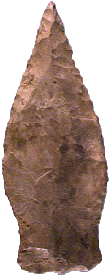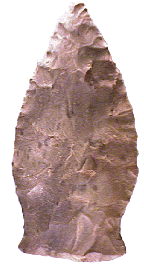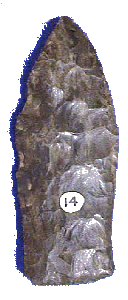



Point Type: COPENA-Classic
Form
Also See: Friday, Kinney, Nolichucky
Location: Southeastern United States
Associated Dates:
4000 - 1200 B.P. - Late Archaic to Woodland
Morphology: Lanceolate
General Description: The Copena classic form is a medium to large sized lanceolate shaped knife or spear point with excurvate blade edges and a straight to slightly convex base. The hafting area may or may not be ground and the shape tends to expand at the base. Grinding when present is light to moderate. The points were made by fine pressure flaking techniques. The size range of this point is from 60 mm to 130 mm, the average being 75 mm. This point usually occurs in Woodland burial mounds, but is also found in Late Archaic sites in Tennessee. The Alabama and Tennessee forms are usually very thin with high quality primary and secondary flaking. They were often made of Fort Payne or Dover chert.
There are many subtypes in the Copena family. They are Auriculate, Pentagonal, Round Base, Triangular and Triangular II. The type is found along the Tennessee River Valley, in parts of Alabama, Mississippi and Tennessee as well as in other sections of the surrounding region including Kentucky.
The Copena type was named by William S. Webb and David DeJarnettee in 1942 for examples found in the Pickwick Basin of northern Alabama. The Copena type was named after the Copena burial mound culture in North Alabama. The Copena name is derived from the first three letter of copper and the last three letters of the mineral galena. Copper and galena artifacts are often associated with Copena burials.
About the Point Above (Left): The point pictured at the left top of this page, is an average sized Copena blade. The blade measures 79 mm in length and measures 38 mm at its widest point. The maximum blade thickness is 9 mm. The point represents the classic rapier point style of the Copena type. It has a flaired base and an incurvate stem or hafting area. The stem and base are very lightly ground. It is made from a rather dull brownish grey chert with darker, purpleish streaks. The edges are quite sharp and the rapier style tip is quite beatuiful to my eye. The point was found in Faxon, Benton County, Tennessee. Catalog Number 15-45-DV
About the Point Above (Right): The point pictured at the top right of this page, is a small sized Copena blade. The blade measures 61 mm in length and measures 38 mm at its widest point. The maximum blade thickness is 6 mm. The point represents the classic point style of the Copena type. It has a flaired base and an incurvate stem or hafting area. The stem and base are very lightly ground. It is made from a rather dull brownish grey chert with darker brown spots. The point is from the former Johnnie Woodard Collection, Dickson, Dickson County, Tennessee. Catalog Number 69-55-D
About the Point Below: The point pictured below, is an average sized Copena blade. The blade measures 77 mm in length and measures 33 mm at its widest point. The maximum blade thickness is 6.5 mm. The point has two small use nicks in the left blade edge. The right blade edge, having been reworked, is quite sharp. The blade is made of a glossy dark tree-bark brownish flint with a few small veined inclusions. It is highly patinated. This point was found in Big Sandy, Benton County, Tennessee. Catalog Number 14-25-D

References: Baker, Bell (2), Cambron & Hulse, Hranicky, Overstreet, Perino (1), Powell, Waldorf
© Copyright 1997 - 2008 LITHICS-Net WWW.LITHICSNET.COM
Use Your Browser's BACK Button to Return to the LITHICS-Net Index.